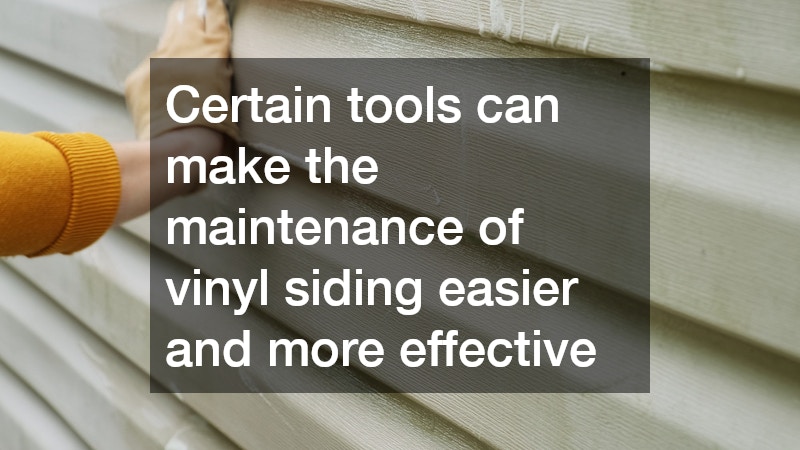Asking an expert for maintenance advice is a crucial step for any homeowner. A local siding company can help provide essential maintenance tips for vinyl siding and address common concerns to help homeowners keep their siding in top condition.
How Often Should You Clean Vinyl Siding?
Regular cleaning is crucial for maintaining the appearance and durability of your vinyl siding. It is recommended to clean your siding at least once a year, especially in areas with a lot of dust or environmental pollutants.
Over time, dirt, leaves, and debris can accumulate on the surface of your siding and lead to discoloration or imperfections. It’s important to regularly check your siding, and if you notice buildup, consider a timely clean. Not only will cleaning enhance the curb appeal of your home, but it will also prevent long-term damage caused by neglect.
For homeowners living in regions with harsher weather conditions, like heavy rainfall or snowfall, more frequent cleaning might be necessary. Keeping up with the maintenance of your vinyl siding can save you considerable costs down the line. Ensuring the integrity of your siding through yearly cleanings can fortify its resilience against the elements.
What Cleaning Solutions Are Safe for Vinyl Siding?
When cleaning vinyl siding, it’s important to use the right solutions to avoid damaging the material. Mild soap and water are typically safe, along with specialized vinyl siding cleaners that are free from abrasive ingredients.
Harsh chemicals or abrasive cleaners can strip away the protective finish on your siding or even cause fading over time. Therefore, investing in a cleaner that is specifically formulated for vinyl is a wise choice. These commercial products are designed to break down dirt and grime without damaging the vinyl material.
Additionally, using a mix of vinegar and water can act as a natural and safe alternative to manufactured cleaning solutions. This option is particularly useful for addressing stubborn stains, and it is environmentally friendly. Making informed choices about your cleaning products can protect the longevity of your siding and keep it looking fresh and new.
How Can You Remove Stains from Vinyl Siding?
Stains from mildew, algae, or mold can detract from the look of your vinyl siding. There are several methods for removing these stains, including using a mixture of bleach and water or commercial stain removers designed specifically for vinyl.
When tackling more severe stain issues, it’s advisable to consider a 30% solution of bleach mixed with water for effective removal. This method can swiftly restore the brightness of your siding. Always remember to wear protective gear, such as gloves and goggles, when using bleach to protect yourself from any splashes.
After applying your cleaning solution to the affected areas, scrub gently with a soft-bristle brush to avoid scratching the surface. Rinsing thoroughly with water afterward can ensure that no residues are left behind. Keeping your siding clean not only maintains its aesthetic appeal but also adds to the overall health of your home by preventing mold and mildew growth.
Are There Specific Tools Needed for Maintaining Vinyl Siding?
Certain tools can make the maintenance of vinyl siding easier and more effective. Commonly recommended tools include a soft-bristle brush, a garden sprayer, and an extension ladder for reaching high areas safely.
A soft-bristle brush is ideal for applying cleaning solutions without scratching the surface. Using a garden sprayer allows you to cover larger areas efficiently and ensures an even application of your cleaning solution. For those hard-to-reach spots, an extension ladder is essential, ensuring that you can safely access higher sections of your siding for proper maintenance.
Additionally, investing in a pressure washer can also be beneficial for cleaning vinyl siding, but caution must be exercised with the pressure settings to avoid damaging the material. Understanding which tools to use will significantly improve the ease and effectiveness of your maintenance routine, ensuring that your siding remains in top-notch condition throughout the years.
What Should You Do if Your Vinyl Siding Gets Damaged?
Damage to vinyl siding, whether from severe weather or physical impacts, should be addressed promptly. It’s important to know the steps to repair or replace damaged sections to ensure the longevity and effectiveness of your siding.
If you experience cracks or holes, consider purchasing replacement panels that match your existing siding. Repairing minor damages right away prevents further issues from arising, such as moisture infiltration or pest infestations. If you’re unsure about DIY repairs, don’t hesitate to contact professional siding contractors who can offer guidance or services tailored to your needs.
Regular inspections can help catch damage early, and addressing them accordingly will preserve the overall integrity of your home’s exterior. Your local siding company can provide valuable insights on maintaining your siding, ensuring it remains a visual asset to your property.
Proper maintenance of vinyl siding not only enhances your home’s exterior but also prolongs its lifespan. Following these tips will help you maintain its beauty and functionality, ensuring your siding remains in great condition for years to come.




